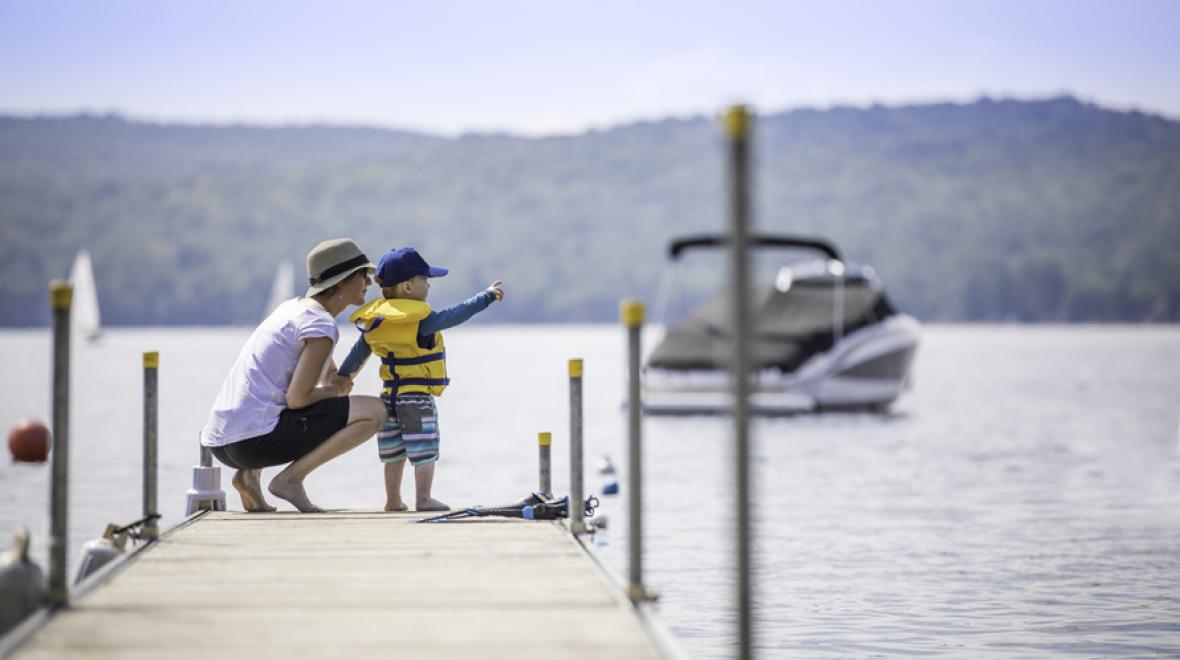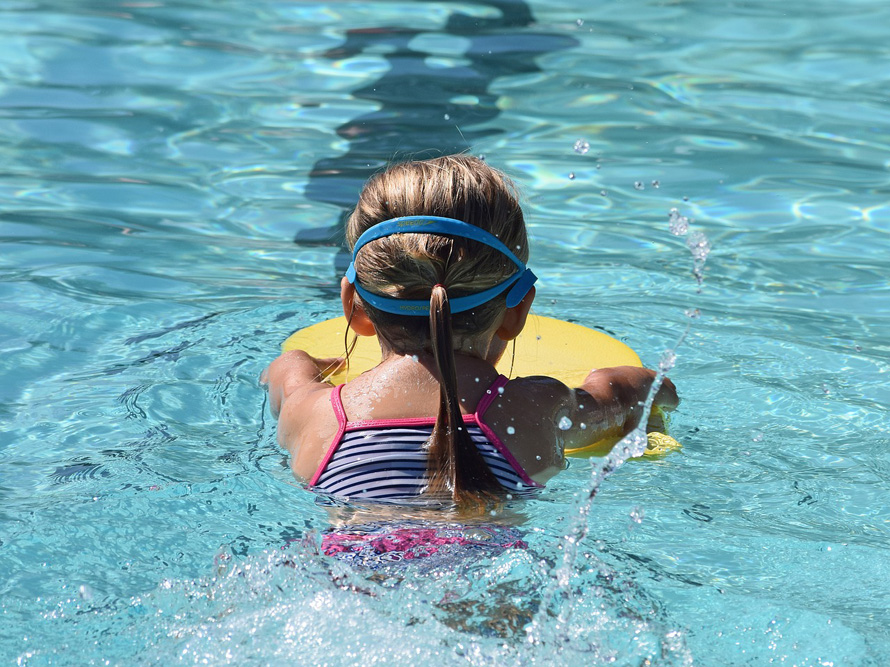
It’s the stuff of nightmares: A young child slips away unnoticed, wanders into a backyard pool and drowns. A teen swimming to a floating dock begins struggling and disappears. News reports of these tragedies and other drowning stories are too common. Drowning is a leading cause of injury death in children. In 2017, almost 1,000 U.S. children and teens died from drowning and 8,700 visited a hospital emergency room because of a drowning event.
The American Academy of Pediatrics (AAP) is taking further action to educate families about water safety. They recently revised their policy statement, Prevention of Drowning, to help pediatricians teach parents about drowning risk and provide prevention strategies that are tailored to each family.
“We know from data that pediatricians don’t spend much time talking about drowning prevention. They have so much to cover in very limited time with families — development, mental health, school readiness or progress, the list goes on. Drowning kind of falls to the bottom,” says Dr. Linda Quan, co-author of the policy statement, and an emergency physician at Seattle Children’s. “What we wanted to do with this policy is highlight that some families are at higher risk for drowning and we can tailor education to their specific risk.”
Age influences drowning risk
The age of the child matters when it comes to risk for drowning. Children ages 1–4 have the highest drowning rates, with drowning causing more deaths of children in this age range than anything else, other than birth defects. Most drownings in young kids occur in bathtubs and swimming pools.
Teens ages 15–19 have the second highest rates of drowning. In the Pacific Northwest, most teen drownings occur in lakes and rivers.
This excerpted post was originally published on the Seattle Children's On the Pulse blog

“In the Seattle area, we’re surrounded by water. Even if your child doesn’t do water activities when they’re young, when they’re older, they may hang out with a buddy who wants to go to the lake, or they may make a friend who has access to a boat,” says Quan. “Teens can get around and go to places unsupervised.”
Males drown more often than females
Boys are almost twice as likely as girls to drown. This may be because they choose riskier activities or overestimate their abilities.
Racial and socioeconomic differences in drowning rates
Traditions, beliefs and resources are involved in drowning risk. According to The Centers for Disease Control and Prevention, African-American children ages 5–14 die from drowning almost three times as often as white children in the same age range. The disparity is greatest in children ages 11–12, where African-American kids drown in swimming pools at rates 10 times those of white kids.
“Children from communities that historically haven’t had much involvement with water are at higher risk for drowning,” explains Quan.
Children with underlying conditions drown at higher rates
Kids with seizure disorders are at increased risk of drowning, especially in the bathtub. Children with autism who wander off also have a heightened risk of drowning.
Environment is an added risk
Families with a pool or spa in their apartment complex, back yard or vacation rental have increased risk of their child drowning. Ponds, lakes, rivers, irrigation ditches, filled buckets and wading pools in a child’s environment also increase risk of drowning. Even toilets and bathtubs are a risk. In addition, families who spend their play or relaxation time near water are in an environment where the risk increases.

Supervision is key
Supervision saves lives. Stay within an arm’s reach of young children and non-swimmers. Never leave a young child alone or in the care of another young child while in or near bathtubs, pools, spas, wading pools, ponds, ditches or other open standing water.
Assign a “water watcher” when kids are swimming and several adults are present. The adult water watcher is in charge of actively supervising the kids with no distractions and no alcohol or drug use. Take turns being the water watcher to stay focused on the job.
Remind teens to swim where there are lifeguards and to use the buddy system. Make clear they should never use alcohol or drugs while in or on the water.
Skill offers some protection
Swim lessons provide skills, build confidence and increase comfort in and around water, but they don’t ensure a child will not drown. Swim lessons can begin as early as age 1–4, and many communities offer free or low-cost swim lessons.
“Finding time to sign up for swim lessons, getting there on time each week and changing your child in a crowded locker room isn’t easy, but it’s so important,” says Quan.
Providing the opportunity to build water skills as your child develops increases their protection against drowning. Water isn’t something you read about and are done. There are different settings, such as lakes and pools, and different hazards. It takes time and practice to gain the basic water competency swim skills of being able to enter the water, surface, turn around, propel oneself for at least 25 yards and then exit the water.
“Most parents stop swim lessons once they feel their child can swim,” says Quan. “Taking lessons over time prepares kids to be water-competent, giving them water safety awareness, basic swimming skills and knowledge of how to help others.”
Life jackets are a layer of protection
Young children should always wear a life jacket when playing in or near the water and on docks. Even if you or your child knows how to swim, children, teens and adults should always wear a life jacket when on a boat, inner tube or other watercraft, and when swimming in open water like a lake, river or the ocean. Non-swimmers should wear life jackets when swimming in pools or open water. Choose appropriate-sized U.S. Coast Guard-approved life jackets.
Research shows that use of life jackets among adults significantly influences whether kids wear them too. Adults are the best role models.
Act to prevent unsupervised access to water
Assess potential risks inside, outside and near your home and any other locations your child visits. This includes other people’s homes, hotels or campgrounds.
- Install and maintain four-sided barriers around pools and other bodies of water. The barrier should separate the water from the house and the rest of the yard with a self-closing, self-latching gate.
- Empty all bathtubs, buckets, containers and kiddie pools immediately after use.
- Store items that can collect water upside down.
- Restrict unsupervised access to the bathroom for very young children.
Caregivers are often prepared for practicing water safety when they know their child will be in or near water. However, many drownings happen when a child gets access to water at a time that no one thought they were going to be near water. This is referred to as unanticipated access to water. Supervision is key at all times that a child has access to water.
Resources
Learn CPR and water rescue skills
Learn CPR and keep a phone with you when at a pool or the beach.
Know water rescue skills, such as “reach, throw and row.” If the victim is close by, reach out to them while you hold on to something or someone stable. Extend your reach with an oar or paddle, a water ski, a fishing pole, a branch, or even a long beach towel.
If you can’t reach the person, throw them something that floats such as a life jacket, life ring, inner tube or inflatable toy. Empty, closed containers can also work for flotation: a cooler with a tight lid, a capped water jug or even a fishing tackle box.
If a boat or any type of small craft is nearby, row or paddle to the victim, bringing along potential rescue items. If motor boats or jet skis are available, cut the engine as you approach, being careful not to swamp the victim with your wake or hit them with the propeller.
New guidelines encourage conversation
The AAP’s recommendations encourage conversations between doctors and families at well-child checkups.
“We need to educate parents about water safety when their kids are young, and reinforce and tailor the education through the years,” says Quan. “We do a great job with this in talking to kids about crossing the street. We need to talk about water safety in the same way, preparing kids for different settings and situations over time.”











